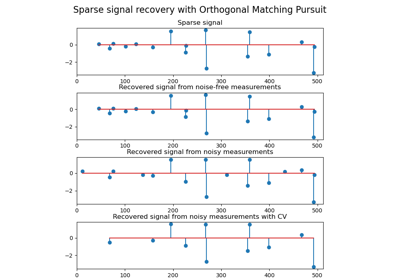sklearn.linear_model.OrthogonalMatchingPursuitCV¶
- class sklearn.linear_model.OrthogonalMatchingPursuitCV(*, copy=True, fit_intercept=True, normalize='deprecated', max_iter=None, cv=None, n_jobs=None, verbose=False)[source]¶
Cross-validated Orthogonal Matching Pursuit model (OMP).
See glossary entry for cross-validation estimator.
Read more in the User Guide.
- Parameters:
- copybool, default=True
Whether the design matrix X must be copied by the algorithm. A false value is only helpful if X is already Fortran-ordered, otherwise a copy is made anyway.
- fit_interceptbool, default=True
Whether to calculate the intercept for this model. If set to false, no intercept will be used in calculations (i.e. data is expected to be centered).
- normalizebool, default=False
This parameter is ignored when
fit_interceptis set to False. If True, the regressors X will be normalized before regression by subtracting the mean and dividing by the l2-norm. If you wish to standardize, please useStandardScalerbefore callingfiton an estimator withnormalize=False.Changed in version 1.2: default changed from True to False in 1.2.
Deprecated since version 1.2:
normalizewas deprecated in version 1.2 and will be removed in 1.4.- max_iterint, default=None
Maximum numbers of iterations to perform, therefore maximum features to include. 10% of
n_featuresbut at least 5 if available.- cvint, cross-validation generator or iterable, default=None
Determines the cross-validation splitting strategy. Possible inputs for cv are:
None, to use the default 5-fold cross-validation,
integer, to specify the number of folds.
An iterable yielding (train, test) splits as arrays of indices.
For integer/None inputs,
KFoldis used.Refer User Guide for the various cross-validation strategies that can be used here.
Changed in version 0.22:
cvdefault value if None changed from 3-fold to 5-fold.- n_jobsint, default=None
Number of CPUs to use during the cross validation.
Nonemeans 1 unless in ajoblib.parallel_backendcontext.-1means using all processors. See Glossary for more details.- verbosebool or int, default=False
Sets the verbosity amount.
- Attributes:
- intercept_float or ndarray of shape (n_targets,)
Independent term in decision function.
- coef_ndarray of shape (n_features,) or (n_targets, n_features)
Parameter vector (w in the problem formulation).
- n_nonzero_coefs_int
Estimated number of non-zero coefficients giving the best mean squared error over the cross-validation folds.
- n_iter_int or array-like
Number of active features across every target for the model refit with the best hyperparameters got by cross-validating across all folds.
- n_features_in_int
Number of features seen during fit.
New in version 0.24.
- feature_names_in_ndarray of shape (
n_features_in_,) Names of features seen during fit. Defined only when
Xhas feature names that are all strings.New in version 1.0.
See also
orthogonal_mpSolves n_targets Orthogonal Matching Pursuit problems.
orthogonal_mp_gramSolves n_targets Orthogonal Matching Pursuit problems using only the Gram matrix X.T * X and the product X.T * y.
lars_pathCompute Least Angle Regression or Lasso path using LARS algorithm.
LarsLeast Angle Regression model a.k.a. LAR.
LassoLarsLasso model fit with Least Angle Regression a.k.a. Lars.
OrthogonalMatchingPursuitOrthogonal Matching Pursuit model (OMP).
LarsCVCross-validated Least Angle Regression model.
LassoLarsCVCross-validated Lasso model fit with Least Angle Regression.
sklearn.decomposition.sparse_encodeGeneric sparse coding. Each column of the result is the solution to a Lasso problem.
Notes
In
fit, once the optimal number of non-zero coefficients is found through cross-validation, the model is fit again using the entire training set.Examples
>>> from sklearn.linear_model import OrthogonalMatchingPursuitCV >>> from sklearn.datasets import make_regression >>> X, y = make_regression(n_features=100, n_informative=10, ... noise=4, random_state=0) >>> reg = OrthogonalMatchingPursuitCV(cv=5).fit(X, y) >>> reg.score(X, y) 0.9991... >>> reg.n_nonzero_coefs_ 10 >>> reg.predict(X[:1,]) array([-78.3854...])
Methods
fit(X, y)Fit the model using X, y as training data.
get_params([deep])Get parameters for this estimator.
predict(X)Predict using the linear model.
score(X, y[, sample_weight])Return the coefficient of determination of the prediction.
set_params(**params)Set the parameters of this estimator.
- fit(X, y)[source]¶
Fit the model using X, y as training data.
- Parameters:
- Xarray-like of shape (n_samples, n_features)
Training data.
- yarray-like of shape (n_samples,)
Target values. Will be cast to X’s dtype if necessary.
- Returns:
- selfobject
Returns an instance of self.
- get_params(deep=True)[source]¶
Get parameters for this estimator.
- Parameters:
- deepbool, default=True
If True, will return the parameters for this estimator and contained subobjects that are estimators.
- Returns:
- paramsdict
Parameter names mapped to their values.
- predict(X)[source]¶
Predict using the linear model.
- Parameters:
- Xarray-like or sparse matrix, shape (n_samples, n_features)
Samples.
- Returns:
- Carray, shape (n_samples,)
Returns predicted values.
- score(X, y, sample_weight=None)[source]¶
Return the coefficient of determination of the prediction.
The coefficient of determination \(R^2\) is defined as \((1 - \frac{u}{v})\), where \(u\) is the residual sum of squares
((y_true - y_pred)** 2).sum()and \(v\) is the total sum of squares((y_true - y_true.mean()) ** 2).sum(). The best possible score is 1.0 and it can be negative (because the model can be arbitrarily worse). A constant model that always predicts the expected value ofy, disregarding the input features, would get a \(R^2\) score of 0.0.- Parameters:
- Xarray-like of shape (n_samples, n_features)
Test samples. For some estimators this may be a precomputed kernel matrix or a list of generic objects instead with shape
(n_samples, n_samples_fitted), wheren_samples_fittedis the number of samples used in the fitting for the estimator.- yarray-like of shape (n_samples,) or (n_samples, n_outputs)
True values for
X.- sample_weightarray-like of shape (n_samples,), default=None
Sample weights.
- Returns:
- scorefloat
\(R^2\) of
self.predict(X)w.r.t.y.
Notes
The \(R^2\) score used when calling
scoreon a regressor usesmultioutput='uniform_average'from version 0.23 to keep consistent with default value ofr2_score. This influences thescoremethod of all the multioutput regressors (except forMultiOutputRegressor).
- set_params(**params)[source]¶
Set the parameters of this estimator.
The method works on simple estimators as well as on nested objects (such as
Pipeline). The latter have parameters of the form<component>__<parameter>so that it’s possible to update each component of a nested object.- Parameters:
- **paramsdict
Estimator parameters.
- Returns:
- selfestimator instance
Estimator instance.
